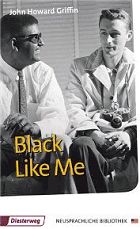
 Black Like Me. Textbook with additional commentaries by John H. Griffin (hier online bestellen)
Black Like Me. Textbook with additional commentaries by John H. Griffin (hier online bestellen)
The story:
John Howard Griffin, the author and main character of Black Like Me, is a middle-aged white man living in Mansfield, Texas in 1959. Deeply committed to the cause of racial justice and frustrated by his inability as a white man to understand the black experience, Griffin decides to take a radical step: he decides to undergo medical treatment to change the color of his skin and temporarily become a black man. After securing the support of his wife and of George Levitan, the editor of a black-oriented magazine called Sepia which will fund Griffin's experience in return for an article about it, Griffin sets out for New Orleans to begin his life as a black man. He finds a contact in the black community, a soft-spoken, articulate shoe-shiner named Sterling Williams, and begins a dermatological regimen of exposure to ultraviolet light, oral medication, and skin dyes. Eventually, Griffin looks in the mirror and sees a black man looking back. He briefly panics, feeling that he has lost his identity, and then he sets out to explore the black community. ....
Excerpt from book:
Griffin would sometimes put white folks to the test. Consider this excerpt:
"...I stopped at a little custard stand and bought a dish of ice cream...Behind the custard stand stood an old unpainted privy leaning badly to one side. I returned to the dispensing window of the stand.
"Yes sir," the white man said congenially. "You want something else?"
"Where's the nearest rest room I could use?" I asked.
He brushed his white, brimless cook's cap back and rubbed his forefinger against his sweaty forehead. "Let's see. You can go on up there to the bridge and then down the road to the left...and just follow that road. You'll come to a little settlement--there's some stores and gas stations there."
"How far is it?" I asked, pretending to be in greater discomfort than I actually was.
"Not far--thirteen, maybe fourteen blocks."
..."Isn't there anyplace closer?" I said, determined to see if he would offer me the use of the dilapidated outhouse, which certainly no human could degrade any more than time and the elements had.
His seamed face showed the concern and sympathy of one human being for another in a predicament every man understands. "I can't think of any..." he said slowly.
I glanced around the side toward the outhouse. "A chance of me running in there for a minute?"
"Nope," he said--clipped, final soft, as though he regretted it but could never permit such a thing. "I'm sorry." He turned away.
About the author:
John Howard Griffin (June 16, 1920 – September 9, 1980) was an American journalist and author much of whose writing was about racial equality. He is best known for darkening his skin and journeying through Louisiana, Mississippi, Alabama, and Georgia to experience segregation in the Deep South in 1959. He wrote about this experience in his 1961 book 'Black Like Me'.
More works by him:
A Time to be Human (1977)
Scattered Shadows: A Memoir of Blindness and Vision (2004)
Available Light: Exile in Mexico (2008)
Buchdaten:
Taschenbuch: 282 Seiten
Verlag: Diesterweg; Auflage: Englische Abteilung. (9. Mai 2009)
Sprache: Englisch
ISBN-10: 3425048244
ISBN-13: 978-3425048246
ISBN: 3425048244
Preis: € 8,95
|  Black Like Me. Textbook with additional commentaries by John H. Griffin (hier online bestellen)
Black Like Me. Textbook with additional commentaries by John H. Griffin (hier online bestellen)